Suchergebnisse für "Factsheet%3A Energietechnologien gestalten%2C die f%C3%BCr alle sinnvoll und nutzbar sind"
International Passive House Summer School for Students
Summer School für Design, Konstruktion und Berechnung von Passivhäusern für Studierende österreichischer und europäischer Universitäten organisiert von der Fachhochschule Kärnten. Umfassende Seminarunterlagen stehen als Download zur Verfügung.
Förderung für innovative Energieforschung in Österreich
Innovationsministerium und Klima- und Energiefonds starten 17-Millionen-Euro-Fördercall für klimafreundliche Technologien „Made in Austria“. Einreichfristen je nach Schwerpunkt: 25. Juni 2025 bzw. 12. November 2025
Rückblick: Info-Webinar zur 8. Ausschreibung "Stadt der Zukunft"
Im Rahmen des Webinars zur kürzlich gestarteten 8. Ausschreibung "Stadt der Zukunft" wurden Themen und Instrumente vorgestellt. Zusätzlich wurden praktische Einreich-Tipps, Voraussetzungen und wichtige Deadlines vorgestellt.
IEA Bioenergy: Österreich Newsletter November 2021

In der vierten Ausgabe des IEA Bioenergy Österreich Newsletters werden Highlights aus den österreichischen Beteiligungen an den Tasks des IEA Bioenergy Netzwerkes vorgestellt. Neben diesen Highlights werden ausgewählte Projekte, Veröffentlichungen und Veranstaltungen präsentiert.
Herausgeber: Österreichische Taskdelegierte des IEA Bioenergy TCPs
Deutsch, 17 Seiten
IEA Fortschrittliche Brennstoffzellen (AFC) Annex 34: Brennstoffzellen für Transportanwendungen (Arbeitsperiode 2019 - 2022)
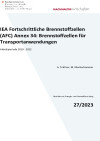
Das Ziel des Projektes ist der Fortschritt von Brennstoffzellen für Transportapplikationen. Um eine flächendeckende Marktdurchdringung von Brennstoffzellen im Automobilsektor erreichen zu können, wird der Fokus auf folgende Aspekte gelegt: Kostenreduktionspotential von Brennstoffzellenkomponenten, - Systemen und Wasserstoffspeichertechnologien, Wasserstoffinfrastrukturen und der Einsatz von brennstoffzellenbetriebenen Fahrzeugen im öffentlichen und Schwerverkehr.
Schriftenreihe
27/2023
A. Trattner, M. Macherhammer
Herausgeber: BMK
Deutsch, 46 Seiten
Downloads zur Publikation
Workshop: ECODESIGN radikal
22. Okt 2008
Hotel Paradies, Straßganger Straße 380b
8054 Graz, AT
Innovation durch öko-intelligente Produkte
WISE - Extension of the safety concept for heat pumps with flammable refrigerants for gas boiler replacement
In the project "WISE", safety concepts are being developed for the event of a leak in which flammable refrigerant escapes from the refrigeration circuit. These concepts aim to ensure a higher level of safety for residential installations than is currently required by the safety standard.
IEA Bioenergy Österreich Newsletter Juli 2024

In der neunten Ausgabe des IEA Bioenergy Österreich Newsletters werden wie gewohnt Highlights aus den österreichischen Beteiligungen an den Tasks des IEA Bioenergy Netzwerkes vorgestellt. Zusätzliche Informationen betreffen ausgewählte Projekte, Veröffentlichungen und Veranstaltungen.
Österreichische Taskdelegierte des IEA Bioenergy TCPs
Herausgeber: IEA Bioenergy TCP (Deutsch/Englisch, 2024)
Mehrsprachig, 14 Seiten
Downloads zur Publikation
Folder: Auf dem Weg zum Plusenergiequartier
Der neu erschienene Info-Folder bietet einen Überblick über Technologien und Teilsysteme für Plusenergiequartiere und liefert Erklärungen, welche strategischen Ziele mit dem Programm „Stadt der Zukunft“ verfolgt werden.
Stakeholderdialog Biobased Industry: Ressourceneffiziente Bioraffinerie – Konversion von Sekundärrohstoffen
Am 7. Dezember werden wieder aktuelle Forschungs-und Entwicklungsaktivitäten im Themenfeld Biobasierte Industrie aus der FTI-Initiative "Produktion der Zukunft" und dem Biobased Industries (BBI) Joint Undertaking präsentiert.
Strategic Research Agenda
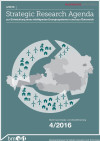
zur Entwicklung eines intelligenten Energiesystems in und aus Österreich
Schriftenreihe
4 /2016
Herausgeber: BMVIT
Deutsch, 98 Seiten
Downloads zur Publikation
CombiSol
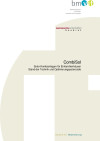
Solar-Kombianlagen für Einfamilienhäuser. Stand der Technik und Optimierungspotenziale
Schriftenreihe
29/2011
A. Thür, G. Kuhness, J.Breidler
Herausgeber: BMVIT
Deutsch, 71 Seiten
Downloads zur Publikation
Institutionelle Innovationsstrategien
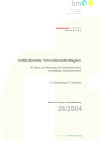
60 Ideen zur Initiierung und Umsetzung eines nachhaltigen Strukturwandels
Schriftenreihe
26/2004
D. Kanatschnig, P. Schmutz
Deutsch, 86 Seiten
Downloads zur Publikation
Aktueller Newsletter - IEA Bioenergy Task 33 "Thermal Gasification of Biomass"
Der erste Newsletter des IEA Bioenergy Task 33 informiert über Aktivitäten innerhalb des Tasks, Hintergrundinformationen zum Thema Biomassevergasung sowie über neueste Entwicklungen in den Mitgliedsländern.
PH-Sanierungsbauteilkatalog
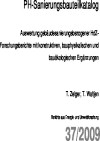
Auswertung gebäudesanierungsbezogener HdZForschungsberichte mit konstruktiven, bauphysikalischen und bauökologischen Ergänzungen
Schriftenreihe
37/2009
T. Zelger, T. Waltjen
Herausgeber: BMVIT
Deutsch, 249 Seiten
Downloads zur Publikation
Komfortlüftung plus+
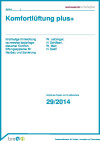
Erstmalige Entwicklung raumweise bedarfsgesteuerter Komfortlüftungssysteme
für Neubau und Sanierung
Schriftenreihe
29/2014
W. Leitzinger, H. Schöberl, W. Mair, H. Seidl
Herausgeber: BMVIT
Deutsch, 29 Seiten
Downloads zur Publikation
IMMO-Rate
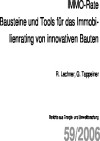
Bausteine und Tools für das Immobilienrating von innovativen Bauten
Schriftenreihe
59/2006
R. Lechner, G. Tappeiner
Deutsch, 124 Seiten
Downloads zur Publikation
Energieforschungsstrategie für Österreich
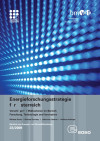
Vorschläge für Maßnahmen im Bereich Forschung, Technologie und Innovation
Schriftenreihe
23/2009
Michael Paula, Michael Cerveny, Johannes Gadner, Andreas Indinger
Herausgeber: BMVIT
Deutsch, 98 Seiten
Downloads zur Publikation
Resource Conserving Renovation
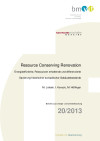
Energieeffiziente, Ressourcen erhaltende und differenzierte Sanierung historischer europäischer Gebäudebestände
Schriftenreihe
20/2013
M. Lorbek, I. Kovacic, M. Höflinger
Herausgeber: BMVIT
Deutsch, 35 Seiten
Downloads zur Publikation
Modellregion Güssing
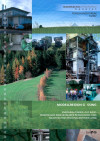
Energieautarkie auf Basis regionaler erneuerbarer Ressourcen und nachhaltige Regionalentwicklung
1/2007
Deutsch, 6 Seiten
